
Exhibit: Outsider Art Inside Lorton
On View: December 04, 2021 – February 28, 2022, McGuire Woods Gallery, W-16
The Workhouse Arts Center is proud to present Outsider Art Inside Lorton, a collaboration with the Lucy Burns Museum. The exhibition features the work of inmate “outsider artists” – artists with no formal training or schooling, who often created art using unconventional materials and methods. Some artwork was created in prison sanctioned programs, such as many of the large murals and the Lorton Photography Workshop, while some pieces were created at the artists’ own leisure.
For more information on the Workhouse’s prison history, visit the Lucy Burns Museum in building W-2, Fridays and Sundays from noon – 5 PM and Saturdays from 11 AM to 5 PM.
The Murals at Lorton Prison
Live Forever Mural, Detail #10, creation date unknown, Photographer: Charles Albert Huckins
Art was everywhere at Lorton Prison – on walls and ceilings, scraps of paper and bodies. Some prisoners produced monumental murals on walls, others scratched graffiti on bunk beds and cell doors. Some paints and brushes were provided by prison sanctioned programs others were obtained surreptitiously.
This type of artistic expression is often called “Outsider Art,” described as art created outside official culture by artists with no formal training, often using unconventional materials and methods. At Lorton, however, art might be better referred to as “Insider Art.”
In the late summer of 2002, just a year after the prison closed, photographer Charles Albert Huckins was invited to a decommissioning ceremony at Lorton Prison. While touring the facilities Mr. Huckins became fascinated with all that had been left behind. Over a series of days Mr. Huckins took over a thousand images. Some of the images are of inmate created murals like the ones depicted here. The images captured by Mr. Huckins have become an invaluable resource for Workhouse Arts Center staff in their continued study of the history of Lorton Prison.
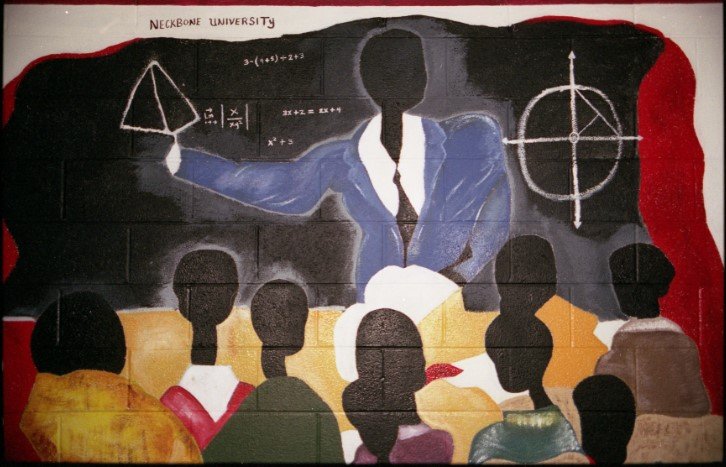
Neckbone University
Location in Prison: Hallway, Building R-43; Central Facility
Date of Photo: 2002; Mural creation date – 1993
Photographer: Charles Albert Huckins
25 ½ in x 19 ½ in
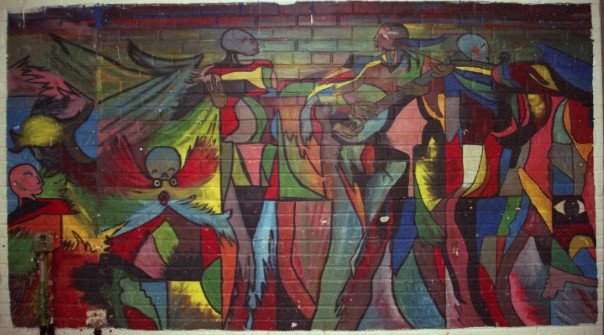
Fantasia Mural
Location in Prison: Entry Room, Cellblock 5, Maximum Security – Central Facility
Date of Photo: 2002; Mural creation date – unknown
Photographer: Charles Albert Huckins
25 ½ in x 19 ½ in

Africa Mural
Location in Prison: Central Facility
Date of Photo: 2002; Mural creation date – unknown
Photographer: Charles Albert Huckins
19 ½ in x 25 ½ in

Live Forever Mural, Detail #10
Location in Prison: Exterior North Wall, Building W-18, Occoquan Facility
Date of Photo: 2002; Mural creation date – unknown
Photographer: Charles Albert Huckins
25 ½ in x 19 ½ in
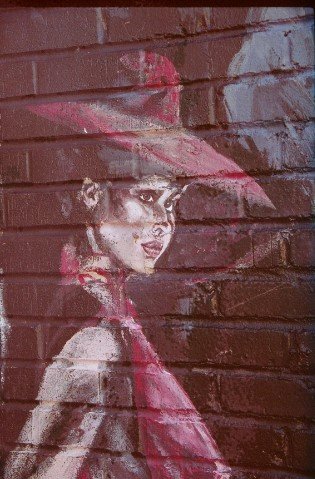
Lady in Red (Detail – Live Forever Mural)
Location in Prison: Exterior North Wall, Building W-18, Occoquan Facility
Date of Photo: 2002; Mural creation date – unknown
Photographer: Charles Albert Huckins

Live Forever Mural
Location in Prison: Exterior North Wall, Building W-18, Occoquan Facility
Date of Photo: 2002; Mural creation date – unknown
Photographer: Charles Albert Huckins
25 ½ in x 19 ½ in
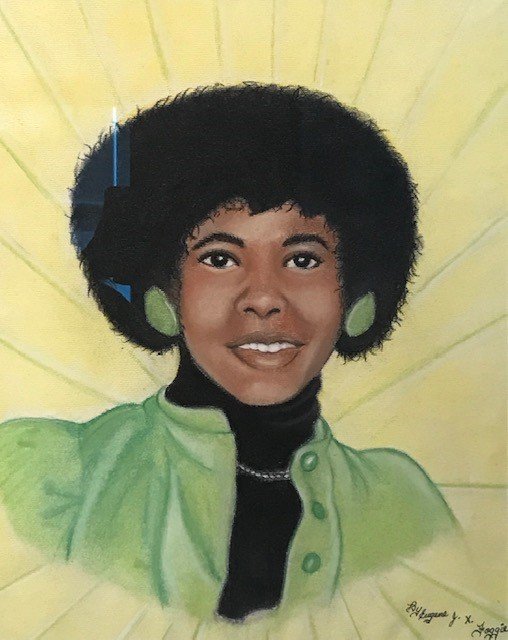
Lady in Green
date unknown
Eugene J. X. Foggie
Pastel
25 in x 29 in
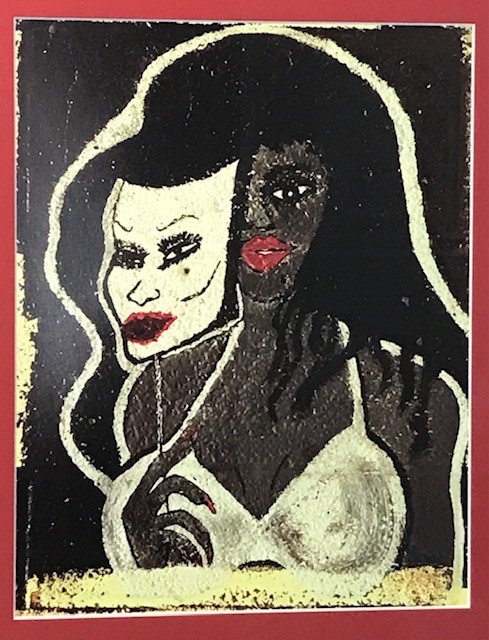
Lady with Mask
date unknown
Artist unknown
25 in x 29 in
Trade skills
were an integral part of Lorton Prison from its start in 1910. Inmates had access to woodworking, metal smithing, and foundry tools. It was common practice for inmates to make gifts for prison staff. Little is known about these pieces, but they could very much have been created as gifts.
Wooden Box, date unknown, Artist unknown, 7 in x 4 ½ in x 5 in
The Lorton Photography Workshop
Karen Ruckman, Diversion in the Yard, 1986, Photographic print, 16 in x 20 in.
The black and white photographs in this exhibition are from the Lorton Photography Workshop, a program at Lorton Prison during the decade of the 1980s. Founded by photographer Karen Ruckman and supported by the DC Commission on the Arts and Humanities, the workshops were a unique moment in prison arts education. Administrators came to more fully appreciate the value of the arts in prison, and the inmates overcame distrust, coming together as a community.
The workshops created a safe space for the men removed from the stressful reality of prison life. They took cameras to venues in the prison school, gym, dorms, and workplaces. Journalists visited the workshop to share the craft of photography, becoming advocates for the program. Over time, the men developed portfolios that reflected a highly personal vision.
Having inmates tell their stories through photography brought new information to the DC community. The images presented a more complex story of incarceration. Prison Photography Curator Pete Brook says the Lorton program “reminds us to make space for prisoners’ humanity, as well as for environments that encourage the arts.”
When individuals change and grow, whole systems change. When we make the invisible visible, we grow in understanding as well as in compassion. The photographs speak to the need for diverse image-makers in criminal justice and offer lessons the photography program contains three decades on.
Bernard Seaborn The Gambler, 1985 Photographic print 16 in x 20 in Taken in the dorm, the image documents an inmate relaxing and passing time by playing cards.
Calvin Gorham Led by the Light, 1985 Photographic print 16 in x 20 in Shooting at night, the photographer explores his spiritual growth through the portrait of fellow members of his gospel singing group
Eugene Clark El Snow in the Hollow, 1984 Photographic print 16 in x 20 in The image was taken during a snowstorm at Lorton. A lone resident walks down an area called “the hollow” by prison inmates.
Karen Ruckman Diversion in the Yard, 1986 Photographic print 16 in x 20 in The men in the foreground are sharing information about the camera, while men in the background play racquetball. The area of the ball court was used for sports and educational activities.
Karen Ruckman Homesick: Father and Child, 1986 Photographic print 16 in x 20 in The men prized photographs of their children. They often made copies of them and liked to be photographed with their photos of their children and family members.
Karen Ruckman Inside the Darkroom, 1984 Photographic print 16 in x 20 in The photograph documents the Lorton darkroom. It was a popular gathering place. We see recently printed prints drying. Post photographer Craig Herndon is chatting with the men.
Karen Ruckman The Fence, 1981 Photographic print 16 in x 20 in The prison residents lived in dorms connected by a courtyard, contained by a high metal fence. They often congregated along the fence, watching the events around the prison, and the comings and goings of visitors.
Karen Ruckman Workshop Participants, 1987 Photographic print 16 in x 20 in The men in the photograph were all part of the 1987 photography class. They are posing for their graduation invitation.
Michael Moses El Pinnacle of Love, 1985 Photographic print 16 in x 20 in This is a self portrait by the photographer. The images on the wall were portraits of his wife that he took on her visits to the prison.
Michael Moses El Twilight Zone, 1984 Photographic print 16 in x 20 in A man stands in a dorm hallway. Two men sit by the door. The light is shining in from the back, creating an atmosphere of other-world reality.











